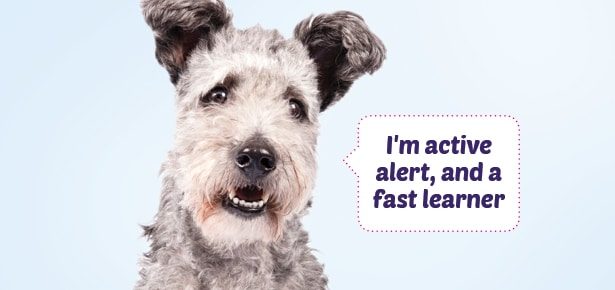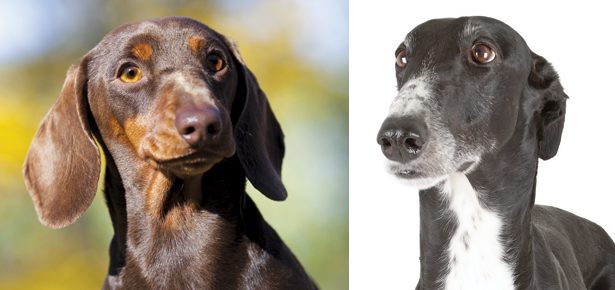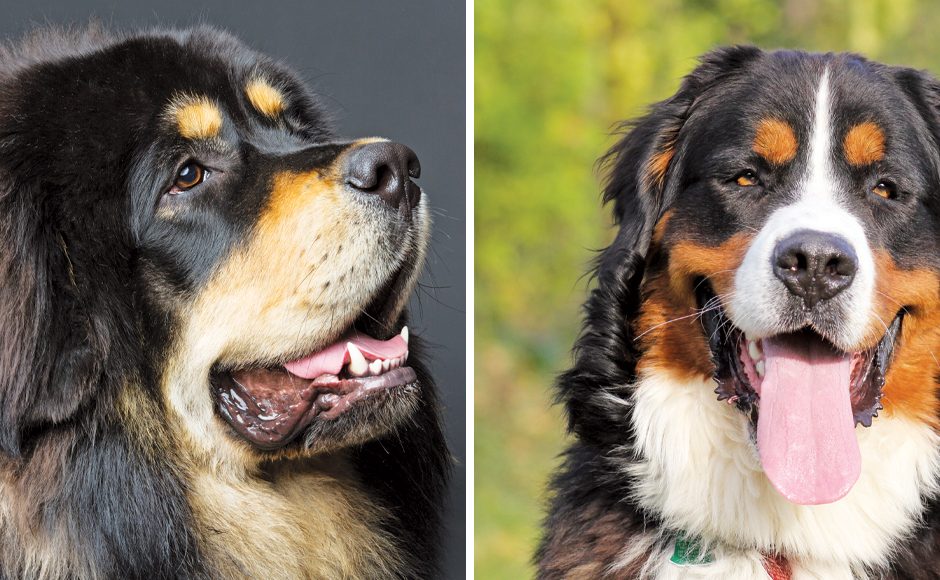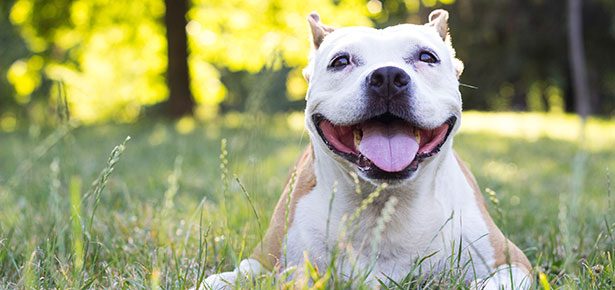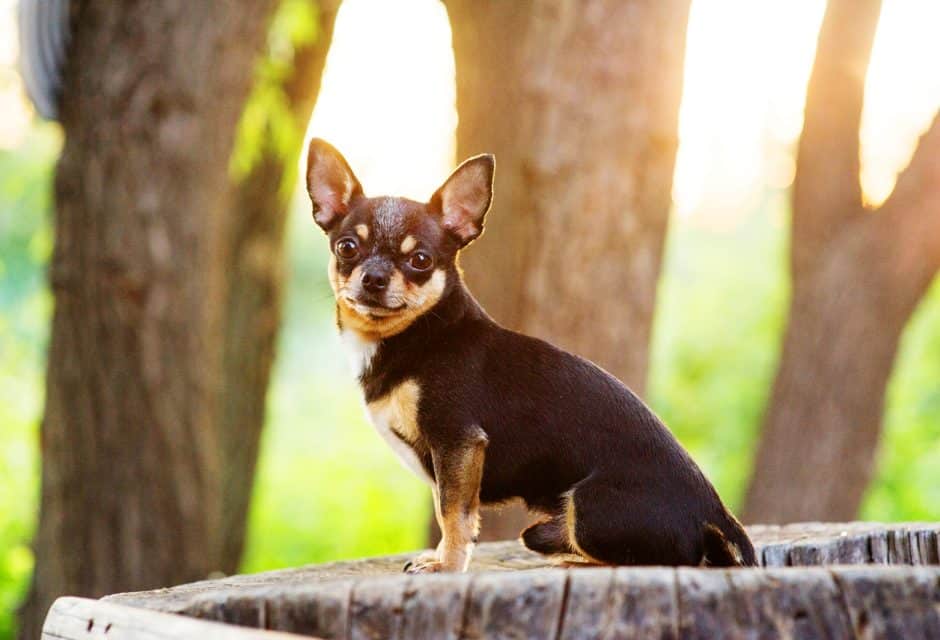
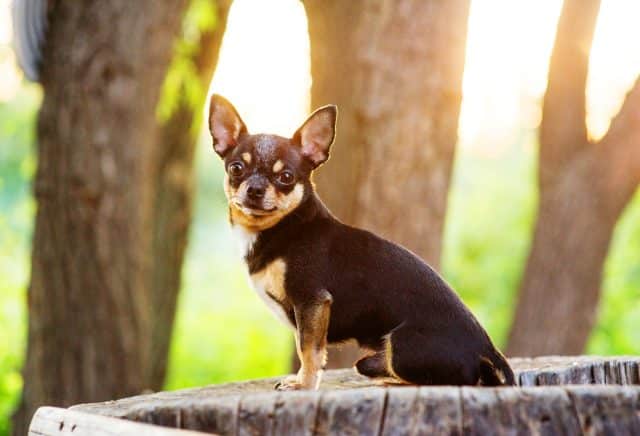
The Chihuahua
Small Sassy Charmer

No, it’s not a rat, nor a toy – it’s a dog, a real dog, with teeth and attitude. Tiny in size but large in spirit, the Chihuahua is one of those highly evolved breeds that has managed to convince most humans that it should be carried around everywhere. Of course for a Chihuahua simply walking down a sidewalk or hanging out in the kitchen can be a risky business. At less than six pounds, a little buddy subjected to a careless misstep by a human can be badly injured. However most Chihuahuas are very affectionate anyhow and prefer cuddling close to their humans.
The Chihuahua is an old breed with an obscure history. Most believe that it originated in Mexico with the Mayans, Toltecs and Aztecs, but other less favoured theories suggest Egypt, Malta, or even China. Certainly the indigenous people of Central America kept small dogs that the rich seemed to revere enough to want buried alongside themselves after death. The dogs were apparently ritually sacrificed after their masters died, under the belief that the sins of the master were then transferred to the dog, ensuring safe passage of the (human) soul to its final resting spot.
The poor also revered these dogs but tended to appreciate them while still lively enough to eat. Following his arrival on the shores of Mexico in 1517, Hernando Cortes found enormous markets with “daily more than sixty thousand souls buying and selling,” where all kinds of animals were to be found for sale, including birds, “rabbits, hares, venison, and small dogs which they castrate for the table.” Some vendors even specialized in the breeding and trafficking of dogs, and certain types were considered more delectable than others.
The Spaniards who conquered the great Aztec societies likely had smallish dogs on their ships as ratters, and these may or may not have interbred with the native dogs.
Much of the early evidence of the possible Chihuahuan ancestry in the New World is inferred from old manuscripts translated from Spanish, from clay figurines, or from other archaeological artifacts on which dogs were engraved. A key to interpreting skeletal evidence is the presence or absence of something called a molera, which is a soft spot on the top of the head similar to the one found on newborn babies.

Chaay_Tee/Bigstock
Among modern-day breeds it is considered unique to Chihuahuas (though it is not found on all individuals). The molera, if present, can be felt by gently stroking the top of the head.
What is known is that in the mid-1800s, American visitors to Mexico became enthralled with a certain tiny type of dog they found living with the peasants there. The name “Chihuahua” is derived from one of the northern Mexican states from which some of these dogs were obtained. Brought to the United States, the little fellows gradually gained popularity as pets. They began to be exhibited at dog shows, and in 1904 the American Kennel Club (AKC) granted them recognition as a breed.
While small, in modern Chihuahua is a compact, solidly built dog that gives a general impression of alertness and balance. It has a round, apple-like skull with low-set, flaring ears and a moderately short muzzle that should emerge from the skull at a 90-degree angle (i.e., there should be plenty of stop.) The eyes should be wide-set, large and round but not protruding.
There are two coat varieties, smooth and long, and both shed. Smooth coats may or may not have an undercoat; long coats may be either flat or curly and usually have an undercoat. Often with long coats there is fringing on the ears and feathering on the legs. All colour and patterns are acceptable in both coat types.
Dogs heavier than six pounds are considered outside the AKC breed standard but otherwise there are no restrictions on size. There are also no official sub-groupings within the breed (i.e., while some individuals may be especially tiny, there is no “Miniature Chihuahua”).
The temperament of the Chihuahua is described as terrier-like. These are spirited, curious, confident dogs, feisty and brave. Many seem to come into the dog park thinking they’re the biggest studs in town. What can be comical is that a much larger dog will often back down from a charging Chihuahua – though from fear or sheer disbelief is not clear. Chihuahuas are excellent watchdogs, loyal and quick to defend their homes and families; however this brave temperament can be a liability in a city where predators like coyotes are common, as the little dogs can easily be snatched and borne away (as can cats who have learned to stand their ground against dogs).
Playful, intelligent and deeply affectionate, Chihuahuas like little more than to cuddle with their humans. They tend to be excellent apartment-dwellers, as they can get much of the exercise they need indoors and often seem to prefer the comforts of home to the great outdoors. (Concrete? No thanks. Up! Up!) Forget “couch potato” – these are lap potatoes. But it is more than a simple matter of a comfort-loving temperament. Keeping Chihuahuas, especially those with single coats, warm in cold or wet weather is something that needs to be taken seriously. All else being equal, small dogs have a lower tolerance for cold than large ones through the basic geometric fact of their body surface (heat=radiating area) being large relative to their volume (furnace power). Raincoats are sweaters are well worth considering.
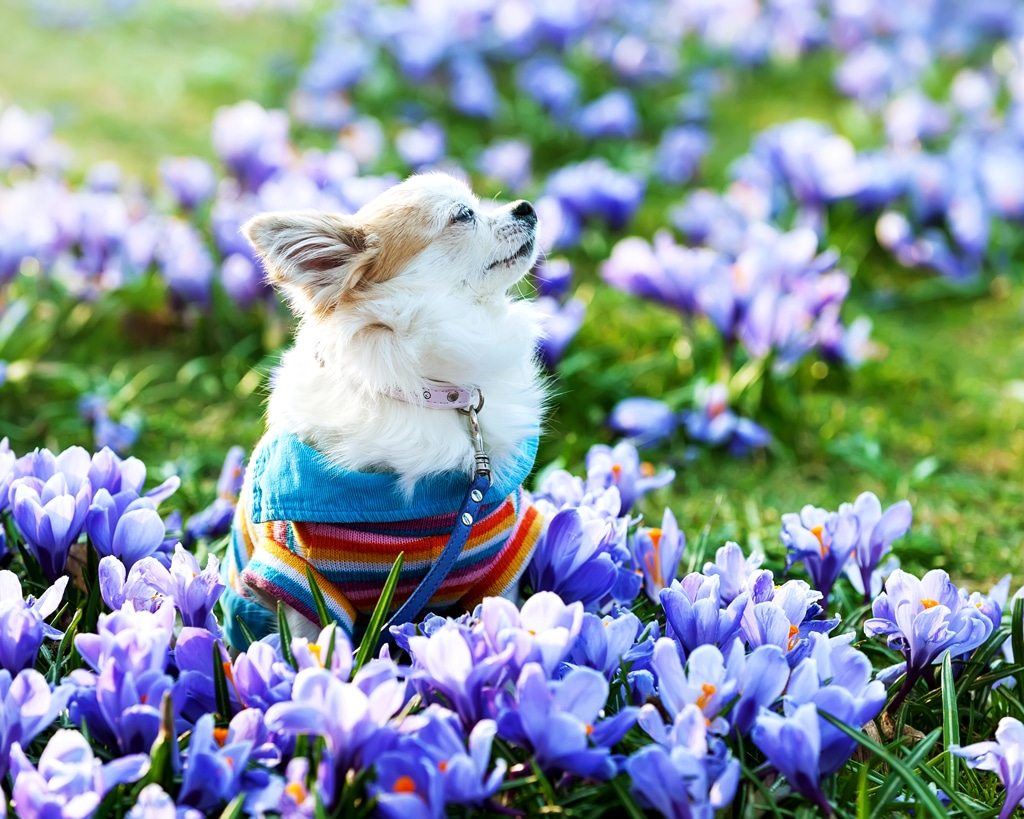
niknikpo/Bigstock
Chihuahuas do like their food, and it is easy to overfeed them since they are so small. A single piece of kibble is relatively big to a six-pound dog, and treats designed for Labrador-sized beasts are veritable banquets. It is always kinder to keep a dog’s weight down to its proper level and particular care must be taken with the tiny breeds.
If Chihuahuas have a negative reputation, it is often that they seem “snappy,” “yappy” or “sharp.” In part this is probably due to their strong attachment to their humans (they are not particularly drawn to strangers) and the fact that everything else in the world is so big. It can also be a result of poor breeding. However a large factor in the behaviour of any dog derives from the attitudes of its human caregivers. With a dog that can be carried around like a baby and whose bite is a joke (though from personal experience, a Chihuahua bite is not always funny), owners are often overindulgent and can lack a sense of the need for training. A Rottweiler must be trained. A badly behaved or poorly socialized Chihuahua, on the other hand, is unlikely to get an owner into much trouble.
But underneath it all, a Chihuahua is not really all that different from other dogs – and is happier with consistent training, fair guidelines and discipline, and a clear sense of who is alpha in the household. (And it’s not the dog.) Chihuahuas are extremely trainable dogs, capable of learning all kinds of cute tricks, but at the minimum they will give their owners much greater pleasure if taught basic manners as all dogs should be. If not, Chihuahua owners will likely find themselves being trained by their clever companions instead.
The Chihuahua is a great city dog and a fine little buddy. Contrary to the beliefs of many, it is a true dog if treated as such, and will reward a loving human family with great charm, loyalty and affection. Tiny breeds have special needs (for example, they cannot be left outdoors) but are easier to keep in countless ways. If your lifestyle suits a Chihuahua, a Chihuahua may suit you. But be prepared to buy new colour coordinated clothing as he will probably want to be in your arms a lot.
» Read Your Breed For more breed profiles, go to moderndogmagazine.com/breeds
Join the newsletter and never miss out on dog content again!
"*" indicates required fields
By clicking the arrow, you agree to our web Terms of Use and Privacy & Cookie Policy. Easy unsubscribe links are provided in every email.

